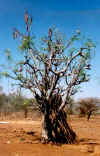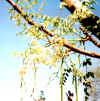|
|
|
Species Name
Moringa
oleifera1
Family
Moringaceae
Local Name(s)
Aleco (Konsogna), Shiferaw (Amargna),
Kalan'gi (Hamer-Bena), Ben-oil tree, cabbage tree, horse-radish tree (English)
General description
A
deciduous tree to 10m, usually smaller, pale feathery foliage. M. oleifera
originates from India, Arabia and was introduced to Ethiopia long ago. The tree
is now naturalized in many parts of southern Ethiopia and has also been tried
elsewhere with varying success. Konso people plant M. oleifera around
their homesteads and also in the terraced fields.
Edible part(s),
preparation methods and palatability
Leaves,
tender young capsules, immature seeds, fruits and roots are edible. The young
leaves are collected, cooked and eaten like other vegetables. The young roots
can be collected and used as a sort of spice. But care should be taken by using
the root as a food because the root bark contains poisonous alkaloids. Also the
fruits are edible even though they are less important than the leaves. Leaves
can easily be dried (in the shade to reduce loss of vitamins) and rubbed over a
wire screen to make a powder that can be stored and conveniently added to soups,
sauces, food without changing their taste. Green immature seeds can be extracted
and eaten like peas, boiled or fried. The flowers that must be cooked, are
consumed either mixed with other foods or fried in butter or oil and have been
shown to be rich in potassium and calcium. The immature green seed pods are
probably the most valued and widely used of all the tree parts. They are
generally prepared in a similar fashion to green beans and have a slight
asparagus taste. The green peas and surrounding white material can be removed
from larger pods and cooked in various ways. The mature seed is about 40% oil.
Moringa seed has a fairly soft kernel, so the oil can be extracted by hand using
a screw press.
Nutritional
value
Leaves contain important
amounts of iron and other valuable nutritional elements as well as high protein
content. Leaves are also outstanding as a source of vitamin A and C as well as a
good source for vitamin B. For a child aged 1-3, a 100g serving of fresh cooked
leaves would provide all his daily requirements of calcium, about 75% of his
iron needs, as well as important amounts of potassium, B vitamins, copper and
all the essential
amino acids. 20g of leaves provides a child with all the vitamins A and C he
needs. The seed pods are highly nutritious containing all the essential amino
acids.
Agroecology
The
species originates from Northern India but it is cultivated throughout the
tropics, especially in arid areas. It is a very drought resistant and valuable
tree. M. oleifera requires well-drained soils with a high water table,
but is drought resistant. Occurs at low altitudes in Dry and Moist Kolla
agroclimatic zones (500 – 1,600m).
Propagation
Method(s)
Direct sowing, cuttings, seedlings.
Sample location
(s)
(1)Konso,
(2) Humbo & (3) Bedesa (SNNPR);
(4) Alduba (Hamer-Bena, South Omo)
Remarks
M. oleifera is a typical multipurpose
tree species with a high economic potential. Besides its leaves' palatability,
the tree produces a number of other useful products. The 'Ben-oil' from
the seeds keeps its quality and so can lubricate precision machinery like
watches. It is also used for salad oil, soap and cosmetics. The ground-up
seeds have been successfully used in the Sudan, Burundi and Kenya to clear
muddy water - a very valuable property. But leaves and the fruits are also
used for medicinal purposes and livestock fodder. Furthermore the tree
is used for bee forage, soil conservation, shade, windbreak, live fence,
boundary marker and for fibres.
In
Konso the leaves are traded on local markets in bundles offered for 10 cents
each.
Parts
of the following description have been taken from Bekele-Tesemma et al., 1993:
p. 316/317; Maundu et al., 1999: p. 181; a publication by the 'Deutsch-Aethiopischer
Verein' that compiles information about the moringa-family from a variety of
sources (see www.deutsch-aethiopischer-verein.de).
Back
to top
|
|

Moringaoleiferatree (Humbo)

Seeds on tree (Humbo)

Flowers and green seeds (Humbo)

Konso children on the way home carrying
their collected fresh young Moringa oleifera tree leaves

Farm fields in Konso with intercropped
Moringa
oleifera trees. Notice the maize in front dried and stunted during
the dry spell in 1998.
|
|